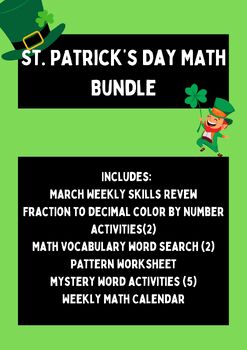4th Grade Math St. Patrick's Day Review Spring Activity Bundle
The Math EduKaytor
7 Followers
Grade Levels
4th, Homeschool
Subjects
Resource Type
Standards
CCSS4.NF.A.1
CCSS4.NF.A.2
CCSS4.NF.B.3b
CCSS4.NF.B.3c
CCSS4.NF.B.4a
Formats Included
- Zip
Pages
45 pages
The Math EduKaytor
7 Followers
Products in this Bundle (10)
showing 1-5 of 10 products
Description
This bundle contains 10 different products that will help your students master their math skills! Included are:
- 5 different Fraction to Decimal mystery word activities
- Weekly Skills Review for the month
- 2 Color by number fraction to decimal activities
- 1 Weekly skills calendar
- 1 Analyzing Patterns worksheet
- 2 Math Vocabulary Word Search puzzles
Total Pages
45 pages
Answer Key
Included
Teaching Duration
1 month
Report this resource to TPT
Reported resources will be reviewed by our team. Report this resource to let us know if this resource violates TPT’s content guidelines.
Standards
to see state-specific standards (only available in the US).
CCSS4.NF.A.1
Explain why a fraction 𝘢/𝘣 is equivalent to a fraction (𝘯 × 𝘢)/(𝘯 × 𝘣) by using visual fraction models, with attention to how the number and size of the parts differ even though the two fractions themselves are the same size. Use this principle to recognize and generate equivalent fractions.
CCSS4.NF.A.2
Compare two fractions with different numerators and different denominators, e.g., by creating common denominators or numerators, or by comparing to a benchmark fraction such as 1/2. Recognize that comparisons are valid only when the two fractions refer to the same whole. Record the results of comparisons with symbols >, =, or <, and justify the conclusions, e.g., by using a visual fraction model.
CCSS4.NF.B.3b
Decompose a fraction into a sum of fractions with the same denominator in more than one way, recording each decomposition by an equation. Justify decompositions, e.g., by using a visual fraction model. Examples: 3/8 = 1/8 + 1/8 + 1/8; 3/8 = 1/8 + 2/8; 2 1/8 = 1 + 1 + 1/8 = 8/8 + 8/8 + 1/8.
CCSS4.NF.B.3c
Add and subtract mixed numbers with like denominators, e.g., by replacing each mixed number with an equivalent fraction, and/or by using properties of operations and the relationship between addition and subtraction.
CCSS4.NF.B.4a
Understand a fraction 𝘢/𝘣 as a multiple of 1/𝘣. For example, use a visual fraction model to represent 5/4 as the product 5 × (1/4), recording the conclusion by the equation 5/4 = 5 × (1/4).





